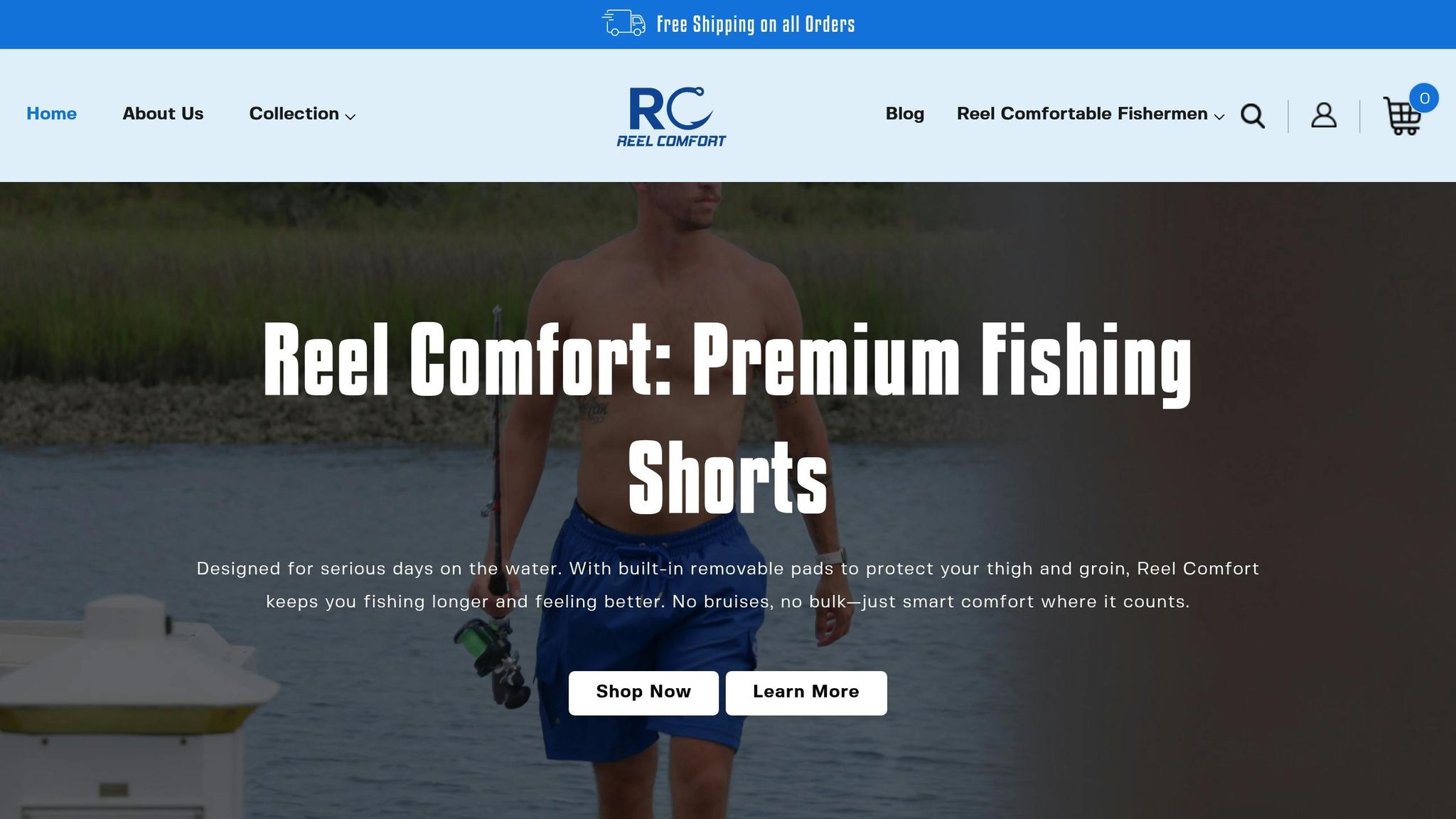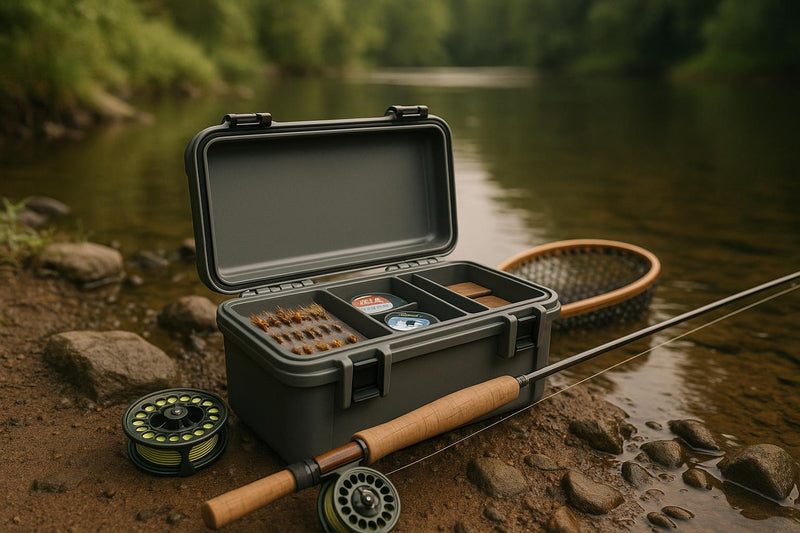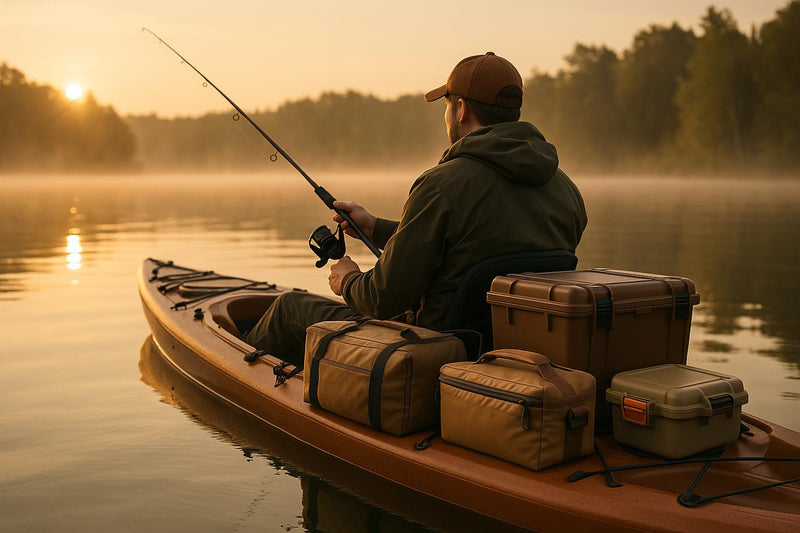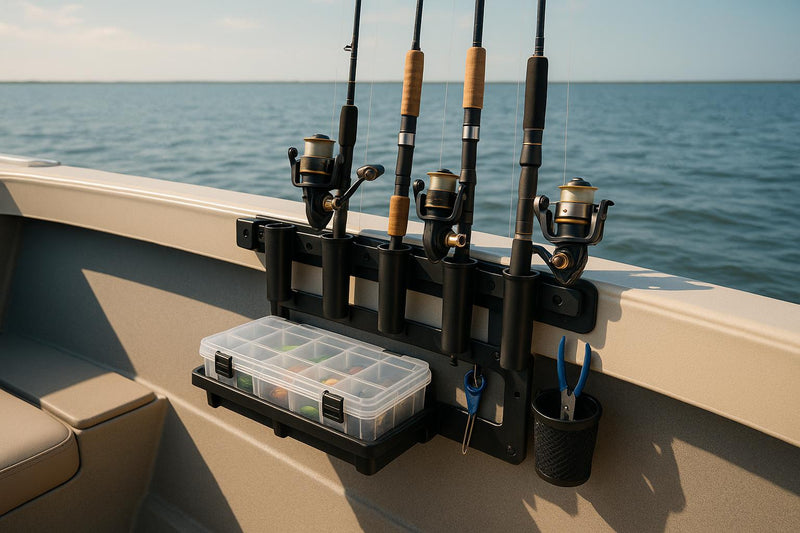DWR (Durable Water Repellent) coatings are a game-changer for anglers, helping keep fishing gear water-resistant, breathable, and long-lasting. Here's why they matter and how to maintain them:
- What It Does: DWR treatments cause water to bead up and roll off fabrics, preventing saturation. This keeps gear lightweight, breathable, and functional.
- Why It Matters: Wet gear loses breathability and becomes uncomfortable. DWR-treated apparel, like fishing shorts, keeps you dry during light rain, splashes, and dew.
- Durability: Proper care can extend DWR effectiveness for 3–5 years. It also protects fabrics from wear caused by water, dirt, and salt.
- Care Tips: Wash with mild detergent, avoid fabric softeners, and use low heat to reactivate the coating. Reapply DWR spray when water stops beading.
DWR-treated fishing shorts strike the right balance between water resistance and comfort, making them a smart investment for anglers. If you're looking for gear that stays dry and lasts longer, consider options like Reel Comfort's $59.99 fishing shorts.
How DWR Technology Works
What is DWR?
Durable Water Repellent (DWR) is a coating applied to fabrics that makes them water-resistant by creating a hydrophobic layer on the surface. Essentially, it alters how water interacts with the material. When water touches a DWR-treated fabric, the coating increases the surface tension, forming tiny, invisible spikes. These spikes force water droplets to bead up and roll off, rather than soaking into the fabric.
Picture it this way: your gear is covered in a microscopic layer of peaks and valleys. When water hits the fabric, it balances on these peaks, forming droplets that effortlessly slide away. For anglers who spend hours on the water, this is a game-changer. DWR prevents the fabric from becoming saturated, maintaining its breathability and ability to release moisture, which is essential for staying comfortable during long fishing sessions.
DWR vs. Waterproof Coatings
It’s important to distinguish between DWR and waterproof coatings when selecting fishing gear. DWR-treated fabrics resist water but aren’t fully waterproof. In heavy or prolonged rain, water can eventually penetrate. This makes DWR ideal for situations requiring water resistance without sacrificing breathability.
On the other hand, waterproof garments are designed to keep you dry even in extreme conditions like heavy rain or snow. These products use membranes or coatings rated by how much water pressure they can withstand before leaking. However, they often compromise breathability, which can be uncomfortable during active pursuits.
For anglers, DWR is the go-to option when comfort and breathability are priorities. Activities like casting, reeling, and moving around generate heat and moisture, and DWR-treated fishing shorts allow internal moisture to escape while repelling external water from splashes or light rain.
| Coating Type | Water Protection | Breathability | Best For |
|---|---|---|---|
| Water-Resistant (DWR) | Light rain, splashes | High | Active fishing, warm weather |
| Waterproof | Heavy rain, submersion | Limited | Storm conditions, cold weather |
| Waterproof/Breathable | Heavy rain protection | Moderate | All-weather fishing |
Materials Treated with DWR
DWR coatings are most commonly applied to synthetic fabrics like nylon, polyester, and their blends. These materials are widely used in high-performance fishing apparel because they naturally wick moisture, enhancing the effectiveness of the DWR treatment.
For example, when applied to men’s fishing shorts, DWR not only boosts the fabric’s quick-drying properties but also adds a protective layer against water exposure. Nylon blends, in particular, are a favorite for fishing gear because they combine durability, stretch, and lightweight comfort. When treated with DWR, these fabrics maintain their flexibility while offering enhanced water resistance - perfect for anglers who need gear that moves with them and keeps them dry.
However, it’s worth noting that DWR coatings aren’t permanent. Over time, exposure to dirt, oils, detergents, and general wear can reduce their effectiveness. To keep your gear performing at its best, regular maintenance is crucial.
For anglers looking to invest in reliable fishing apparel, DWR-treated fabrics strike an excellent balance between water resistance and comfort. This technology bridges the gap between basic water-repellent gear and fully waterproof options, making it versatile enough to handle a wide range of fishing conditions. Understanding how DWR works is the first step toward appreciating its role in durable, high-performance fishing apparel.
How DWR Coatings Improve Fishing Apparel Durability
Better Fabric Longevity
DWR coatings play a key role in protecting fishing apparel from wear and tear caused by constant exposure to the elements. When fabrics are repeatedly soaked, they become more vulnerable to damage from salt, dirt, and other contaminants. DWR treatments prevent this by making water bead up and roll off the surface, rather than soaking into the fibers. This not only keeps your gear dry but also extends its lifespan. In fact, studies suggest that DWR coatings can retain about 80% of their effectiveness even after 20 washes. So, your fishing shorts can keep performing for many seasons. Plus, the coating adds an extra layer of defense against oil and grease, helping to maintain both the look and strength of the fabric over time.
Durability Features in Fishing Shorts
Today’s men's fishing shorts are built with durability in mind, combining DWR treatments with smart design features. High-quality materials like densely woven fabrics and rip-stop construction ensure toughness, while four-way stretch panels and reinforced stitching add flexibility and strength. Anti-chafe seams and features like removable thigh pads further enhance comfort and longevity by evenly distributing wear. Additionally, quick-dry properties reduce the time the material stays wet, which helps protect both the fabric and the DWR coating. Together, these features create fishing shorts that can handle tough conditions while staying comfortable and reliable.
Protection Against Environmental Factors
Environmental challenges, especially in saltwater settings, can quickly wear down fishing gear. DWR coatings act as a barrier, minimizing water absorption and reducing salt buildup, which can degrade fibers over time. While no treatment is completely immune to UV damage, DWR finishes help shield fabrics from direct sunlight, extending their usability. Another benefit is breathability - by preventing the outer layer from becoming waterlogged, these coatings allow sweat and moisture to escape, keeping you comfortable. DWR-treated garments also resist dirt and oils, making them easier to clean and maintain. This combination of water resistance, stain protection, and reduced maintenance makes investing in DWR-treated fishing shorts a practical choice for anglers who demand long-lasting performance from their gear.
Features of DWR-Treated Fishing Shorts
Key Features for Anglers
When you're picking out DWR-treated fishing shorts, there are a few standout features that can make your time on the water better. Quick-dry fabrics paired with DWR coatings help shed water fast while keeping the material breathable.
Ergonomic designs with four-way stretch panels allow unrestricted movement - perfect for casting, reeling, or maneuvering around a boat or shoreline. Handy features like deep hand pockets and secure zippered compartments ensure your essentials stay dry and within reach. For added comfort, removable thigh pads provide extra support when you're bracing yourself.
Durability is another big plus. Anti-chafe seams and reinforced stitching make these shorts tough enough to handle constant movement and wear. These thoughtful design elements are a hallmark of advanced fishing gear, like the options in Reel Comfort's collection.
Reel Comfort Fishing Shorts Features

Reel Comfort has taken these features a step further, fine-tuning their DWR-treated shorts for performance and practicality. The water-resistant, quick-dry fabric ensures you stay comfortable no matter the conditions.
Removable thigh pads offer cushioning for those moments when you need extra support against hard surfaces, while four-way stretch panels keep you flexible without compromising water resistance. Storage is well thought out, with deep hand pockets for easy access and a zippered back pocket for securing valuables. Anti-chafe seams and tough rip-stop fabric mean these shorts are built to withstand the demands of active fishing. Available in black, gray, and blue for $59.99, they highlight how DWR-treated gear can enhance both comfort and durability.
As Aaron Ambur from Whitewater Fishing puts it:
"The very first defense is your DWR treatment, which prevents water from entering the fabric of the garment."
This initial layer of protection ensures that features like breathability and padding continue to work effectively, even in challenging conditions.
DWR-Treated vs. Untreated Shorts Comparison
To understand the value of DWR-treated fishing shorts, it helps to see how they stack up against untreated options. Here's a quick breakdown:
| Feature | DWR-Treated Shorts | Untreated Shorts |
|---|---|---|
| Water Repellency | Water beads up and rolls off | Fabric absorbs water and gets soaked |
| Comfort in Wet Conditions | Stays breathable and avoids a clammy feel | Becomes heavy and uncomfortable |
| Durability | Lasts longer, with proper care lasting 3–5 years | Wears out faster |
DWR treatments prevent fabric saturation, keeping you comfortable and extending the life of your shorts. With proper care, these coatings can stay effective for 3–5 years, making them a smart investment for dedicated anglers.
If you're ready to experience the difference, check out Reel Comfort's collection of fishing shorts.
sbb-itb-cb0a783
Care and Maintenance of DWR Coatings
Washing and Drying Guidelines
Taking proper care of your gear is key to maintaining the water-repelling abilities of DWR (Durable Water Repellent) coatings. Regular washing and drying help remove residues that can interfere with the coating's performance.
After each use - especially if you've been in saltwater - rinse your Fishing shorts with fresh water to prevent salt and grime from building up. When it's time for a full wash, stick to a mild powder detergent. Wash your shorts separately, either by hand or on a delicate machine cycle. If possible, opt for technical fabric cleaners, as they're specially designed for DWR-treated materials. Stay away from regular detergents, which can weaken the treatment.
Heat is crucial for reactivating DWR. If the care label allows, tumble dry your shorts on a low to medium heat setting for about 30 minutes. No dryer? No problem. You can also use a warm iron without steam - just place a towel or cloth between the iron and the fabric to protect it. For stubborn stains, spot clean before washing to avoid harsher methods that might damage the coating.
Once your shorts are clean and dry, keep an eye on the coating's performance to determine when it might need a refresh.
When to Reapply DWR Treatments
Over time, normal wear, sunscreen, insect repellent, and repeated washing can diminish the effectiveness of DWR. To test your shorts, sprinkle water on them. If the water beads up and rolls off, the coating is still doing its job. If the water soaks in and darkens the fabric, it's time for a reapplication.
Start by washing your shorts with a technical fabric cleaner to remove oils and dirt. Then, dry them using low or medium heat in a dryer (if the care label permits) or use a warm iron with a protective cloth. Once dry, apply a new DWR coating using a spray-on or wash-in product, carefully following the instructions provided by the manufacturer.
It's worth noting that newer, eco-friendly DWR treatments may require more frequent maintenance. For example, in 2016, Burton switched to short-chain C6 DWR, which is a step toward more sustainable options.
Sticking to proper reapplication steps can help you avoid common maintenance pitfalls.
Common Maintenance Mistakes
Certain mistakes can drastically reduce the effectiveness of your DWR coating. Avoid using fabric softeners, harsh detergents, bleach, or dry cleaning chemicals, as these can leave residues or cause permanent damage.
High heat can break down the coating, while skipping heat altogether after washing means missing the chance to reactivate it. Always follow the care label and stick to low or medium heat settings.
Storage matters, too. Never store your shorts while they're damp, as this can lead to mildew and fabric damage. Instead, keep them in a cool, dry place and avoid compressing them for long periods.
Products like bug spray and sunscreen can also reduce DWR performance. While these are often unavoidable during fishing trips, try to limit direct contact with your shorts when applying them. Additionally, avoid wringing the fabric during washing, and rinse thoroughly to remove any detergent residue.
NixWax - Durable Water Repellent application on fishing rain gear

Choosing the Right DWR Fishing Shorts
When you're out fishing for long hours, the last thing you want is uncomfortable, soggy gear. That's where DWR-treated fishing shorts come into play. These shorts are designed to repel water, dry quickly, and handle everything from boat spray to sudden weather changes. Compared to untreated options, DWR-treated shorts deliver reliable performance, keeping you dry and comfortable throughout your trip.
When shopping for fishing shorts with DWR treatment, focus on a few essential features:
- Secure storage: Look for multiple pockets, especially zippered ones, to keep your essentials safe.
- Sun protection: A high UPF rating helps shield your skin from harmful UV rays.
- Quick-drying fabrics: Materials that wick moisture away are a must for comfort.
- Flexibility: Blends like nylon and spandex provide the stretch you need for unrestricted movement.
Durability is another critical factor. Many outdoor brands measure DWR performance at an 80/20 level, meaning the coating retains 80% of its effectiveness even after 20 washes. Investing in high-quality DWR-treated shorts pays off in the long run, offering both performance and value over time.
For a reliable choice that meets all these criteria, check out Reel Comfort's Fishing shorts. Designed with durability, comfort, and advanced DWR protection, they are built to withstand the demands of fishing.
Final Recommendation
If you're looking for the ideal blend of comfort, durability, and water resistance, Reel Comfort's Fishing shorts are a top pick at $59.99. These shorts feature supportive padding to reduce pressure, quick-drying fabric to keep you comfortable in wet conditions, and practical storage for your tackle and other essentials.
The shorts are made with water-resistant materials and reinforced stitching, ensuring they can handle saltwater, sun exposure, and repeated washes - everything a serious angler needs. Available in Black, Gray, and Blue, these Mens Fishing Shorts combine DWR technology with thoughtful design for fishing challenges.
Craig Lamb from Bassmaster sums it up perfectly:
"Water beads off, which is ideal when encountering boat spray, fish splashes or any brief encounter with water. Even if they get wetter, the shorts quickly dry out. DWR also adds stain resistance from fish blood and other liquids".
With proper care, these DWR-treated shorts will be a dependable part of your fishing gear for years to come.
FAQs
How do I know when to reapply a DWR coating to my fishing gear?
When water stops forming beads on the surface of your gear and begins to soak in - known as "wetting out" - it’s a clear sign that your Durable Water Repellent (DWR) coating needs a refresh. Over time, factors like heavy use, dirt buildup, or frequent washing can wear down the coating’s effectiveness.
To keep your gear performing at its best, it's a good idea to reapply the coating every 3–6 months or at the start of each fishing season. Be sure to check and follow the care instructions specific to your gear to help preserve the coating for as long as possible.
What’s the difference between DWR-treated and fully waterproof fishing gear?
DWR-treated fishing gear is coated with a Durable Water Repellent (DWR) finish, which makes water bead up and slide off the surface. This treatment helps resist water, making it a good choice for light rain or occasional splashes. However, it’s not completely waterproof - prolonged exposure or heavy rain can still allow water to seep through.
In contrast, fully waterproof gear is crafted with waterproof fabrics and sealed seams, providing complete protection even during heavy rain or when submerged. While DWR coatings fade over time and require reapplication, waterproof gear is designed for long-lasting, water-tight performance, ensuring anglers stay dry in consistently wet conditions.
What is DWR coating, and how does it improve the durability of fishing shorts?
DWR, short for Durable Water Repellent, is a treatment applied to fabrics to make them resistant to water. This coating works by preventing water, dirt, and stains from penetrating the material, keeping it clean and minimizing damage caused by moisture and grime.
By keeping fabrics dry and free of debris, DWR coating helps fishing shorts last longer and perform better. For anglers, this means dependable gear that stands up to extended fishing trips and regular use without sacrificing comfort or practicality.




